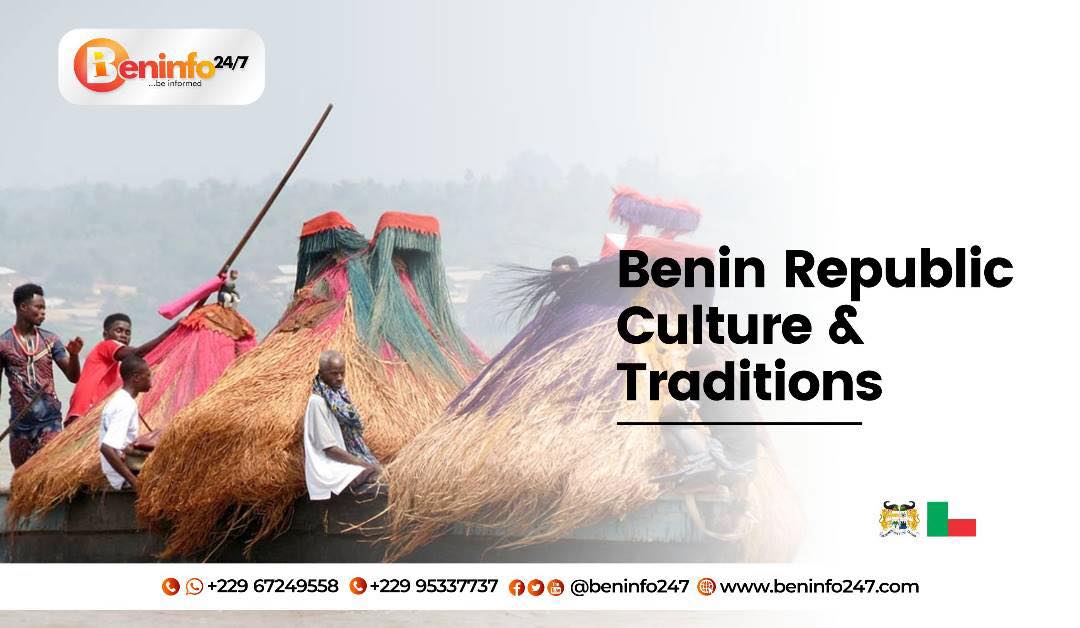Benin Republic Culture And Traditions
The Republic of Benin, formerly known as Dahomey under French colonial rule, underwent several name changes throughout its history. After Major Kérékou seized power in a coup, the country was renamed the People’s Republic of Benin, reflecting the Marxist-Leninist ideology of the new government. Following the fall of Kérékou’s regime, the name was shortened to the Republic of Benin. Dahomey was once the most powerful kingdom on the Slave Coast before colonialism, and the country includes areas inhabited by many different ethnic groups. Due to geographic factors and a history that includes waves of migration, pre-colonial kingdom competition, four centuries of European commercial relations, and the impact of colonialism, Benin lacks cultural homogeneity. Divisions exist along lines of language, ethnicity, occupation, and religion.
Benin is bordered by Niger, Burkina Faso, Nigeria, and Togo and covers an area of 43,483 square miles (112,622 square kilometers). The country is divided into five geographic zones, each with distinct characteristics. The coastal south is characterized by narrow strips of coconut palms broken up by lagoons and creeks, while the north features a plateau of fertile iron clay soil with marshy areas and oil palms. The central region is a wooded savanna with some hilly areas, while the Atacora mountain chain in the northwest is the area
The Republic of Benin comprises 84 districts distributed among six departments, with its capital located in Porto-Novo while the seat of government is situated in the largest city, Cotonou.
As for the country’s population, estimates show it to be around 6.5 million, with a high growth rate and a significant concentration in the southern and central regions. Additionally, 48 percent of the population is below the age of fifteen.
Regarding language, French is the national language, and English is taught in secondary schools. There are approximately fifty languages and dialects spoken in the country, with about half of the population speaking Fon. Other significant languages include Yoruba, Aja, Mina, Goun, Bariba, Dendi, Ditamarri, Nateni, and Fulfulde. The country’s literacy rate is estimated to be around 64 percent.
In terms of symbolism, the original flag flown after gaining independence in 1960 featured three colors – green, red, and yellow – symbolizing hope for renewal, the ancestors’ courage, and the country’s treasures, respectively. In 1975, the flag was modified to feature a red star in the corner, representing the country’s socialist ideology. However, the original flag was reinstated in 1990, symbolizing the rejection of Marxist ideology.
The emergence of the nation of Benin can be traced back to the migration of Aja-speaking peoples into the southern part of the country, where they established several kingdoms. The Yoruba also have a longstanding presence in the southern and central regions. The Bariba migrated from what is now Nigeria and established a group of states, while several indigenous groups in the northwest remained independent. European contact began with the Portuguese in the 1580s, and other European powers soon followed, making the coastal communities part of the trans-Atlantic trading system. The slave trade became the dominant commerce in the seventeenth century, initially with coastal kingdoms, but eventually with Dahomey, which dominated the regional slave trade. The royalty of Dahomey sold slaves directly to Brazilian merchants, and traders wrote about the power of the Dahomean monarch, the “amazons” (female warriors) in his army, and ceremonies that included human sacrifice.
French influence in Dahomey (now Benin) increased in the mid-19th century due to commercial and missionary activities, which led to tensions between France and Dahomey. France engaged in three military campaigns against Dahomey, resulting in its defeat and colonization in the federation of French West Africa. The French colonial administration imposed heavy taxation, forced labor, and harsh laws on the people. After World War II, France allowed for increased representation and autonomy, and Dahomey gained independence in 1960. The country experienced political turmoil, with multiple military coups and a period of socialism under the Kérékou regime. During this time, a rhetoric of national unity and “the revolution” was promoted, but national identity is still secondary to ethnic identity for much of the rural population.
Benin recognizes about 20 sociocultural groups, with the Fon being the largest group. The Afro-Brazilian community in the south is descended from European traders, Africans who lived near European trading establishments, and traders who returned slaves from Brazil. Over 40 percent of the population lives in urban environments, primarily in Cotonou, and cities have a mixture of modern and colonial architecture. Food in daily life consists of a staple starch prepared with a sauce containing vegetables and meat or fish, and many varieties of tropical fruits are eaten. The country is self-sufficient in food production, with half the population engaged in agriculture, but transport and infrastructure challenges make it difficult to transport agricultural products to market. Land tenure and property access were primarily through lineages and clans, but private holdings existed before the colonial period as a result of gifts from kings to their supporters and purchases from lineage groups.
The crime rate is low in Benin and most disputes are resolved by local leaders, but theft is a problem and few civilians have access to guns. Military activity has been limited to domestic operations, and civilian rule has been toppled several times by factions of the military. Poverty has prevented the state from addressing the nation’s health and educational needs, and it has relied on foreign aid and assistance from international organizations. Women in Benin are responsible for household tasks involving food and children, and although women were once able to increase their wealth and power in the royal palace organization, the general pattern has always been for women to be socially and economically subordinate to men. Currently, 65 percent of girls in Benin are not in school.
Benin Republic, also known as simply Benin, is a West African country with a rich cultural heritage that reflects the diversity of its people. The culture and traditions of Benin are deeply rooted in its history, religion, art, music, dance, and cuisine. Here are some highlights of the country’s culture and traditions:
- History and heritage: Benin is home to the ancient Kingdom of Dahomey, which was known for its powerful army, wealth, and cultural achievements. The kingdom had a complex system of governance, religion, and social hierarchy, which is still evident in the country’s cultural practices and traditions today. Some of the must-visit historical sites in Benin include the Royal Palaces of Abomey, the Sacred Forest of Kpasse, and the Slave Route.Benin Republic has a rich history and cultural heritage that date back to pre-colonial times. The country was home to the Kingdom of Dahomey, which was founded in the 17th century and lasted until the late 19th century. The Dahomey kingdom was known for its powerful army, which included an elite corps of women warriors known as the Amazons. The kingdom was also known for its cultural achievements, including its intricate woodcarvings, textiles, and metalwork.
In the late 19th century, the Dahomey kingdom was conquered by the French, and Benin became a French colony. The country gained independence in 1960, and has since gone through periods of political instability, including a military dictatorship that lasted from 1972 to 1991. In recent years, Benin has made significant progress towards democratization and economic development.
Today, Benin’s cultural heritage is evident in its many historical sites, such as the Royal Palaces of Abomey, which are UNESCO World Heritage sites. These palaces, which were built by the kings of Dahomey, are known for their intricate woodcarvings, which depict scenes from the kingdom’s history and mythology.
Benin is also home to the Slave Route, a UNESCO World Heritage site that traces the history of the transatlantic slave trade in West Africa. The site includes the Door of No Return, a symbol of the millions of Africans who were taken from their homes and sent to the Americas as slaves.
In addition to its historical sites, Benin is known for its traditional festivals and ceremonies, which celebrate the country’s culture and heritage. One of the most famous festivals is the annual Vodun Festival in Ouidah, which attracts visitors from all over the world. The festival celebrates the traditional religion of Vodun, which is still practiced in Benin today.
Overall, Benin’s history and heritage are a fascinating blend of pre-colonial kingdoms, colonialism, and post-independence struggles. Despite the challenges it has faced, Benin has managed to preserve and celebrate its cultural heritage, making it a unique and rewarding destination for travelers interested in history and culture.
- Religion: Benin is a multi-religious country, with Christianity, Islam, and traditional African religions coexisting peacefully. The traditional religions, such as Vodun, have a strong presence in Benin’s culture and traditions, with many festivals and ceremonies dedicated to the worship of ancestors and spirits. One of the most famous festivals in Benin is the annual Vodun Festival in Ouidah, which attracts visitors from all over the world.Religion has played an important role in the culture and traditions of Benin Republic for centuries. The country is home to a diverse mix of religions, including Christianity, Islam, and traditional African religions.
Traditional African religions, such as Vodun (also known as Voodoo), have a strong presence in Benin’s culture and traditions. Vodun is a polytheistic religion that centers on the worship of deities, spirits, and ancestors. Many festivals and ceremonies in Benin are dedicated to the worship of these spirits, and Vodun priests and priestesses play important roles in community life.
In addition to traditional religions, Christianity and Islam have also made significant inroads in Benin. Christianity, particularly Catholicism, was introduced by European colonizers and missionaries in the 19th and 20th centuries. Today, Christianity is the largest religion in Benin, with around 42% of the population identifying as Christian.
Islam was introduced to Benin through trade routes and migration, and is now the second-largest religion in the country, with around 25% of the population identifying as Muslim. Islam in Benin is primarily practiced by the Fulani and Bariba ethnic groups, who have a long history of trade and migration across West Africa.
Despite the diversity of religions in Benin, the country is known for its religious tolerance and coexistence. Religious festivals and ceremonies are often attended by members of different faiths, and traditional beliefs and practices are often integrated into Christian and Muslim celebrations.
In recent years, the government of Benin has also sought to promote religious tourism, particularly around the traditional religion of Vodun. The annual Vodun Festival in Ouidah, for example, attracts visitors from all over the world and is seen as a way to promote cultural tourism and economic development.
Overall, religion in Benin is a fascinating mix of traditional beliefs and practices, as well as the influence of Christianity and Islam. The country’s religious diversity and tolerance are a testament to its cultural richness and tradition of coexistence.
- Art and craft: Benin is known for its vibrant art and craft scene, with traditional crafts such as pottery, weaving, and woodcarving still practiced today. The country is also home to many contemporary artists and designers who are putting a modern spin on traditional techniques. Some of the best places to buy local crafts in Benin include the Grand Marché in Cotonou and the Artisanal Center in Porto Novo.Art and craft have been an integral part of Benin’s culture and traditions for centuries. The country is known for its intricate woodcarvings, textiles, and metalwork, which are often created using traditional techniques that have been passed down through generations.
One of the most famous art forms in Benin is the woodcarvings produced by the people of the Fon kingdom. These carvings depict scenes from the kingdom’s history and mythology and are often adorned with intricate patterns and designs. The woodcarvings are still produced in the city of Abomey, which was the capital of the Fon kingdom.
Benin is also known for its textiles, particularly the colorful wax prints that are a staple of West African fashion. The wax prints are produced using a batik-like process, in which designs are stamped onto the fabric using wax, and then dyed. The resulting fabric is used to create clothing, accessories, and home decor items.
Metalwork is another important art form in Benin, particularly in the city of Cotonou. The city is home to a large market known as the Dantokpa Market, which is famous for its metalwork, including brass sculptures, jewelry, and household items. Many of these items are created using traditional techniques that have been passed down through generations.
In addition to these traditional art forms, Benin is also home to a thriving contemporary art scene. The city of Cotonou has several art galleries and exhibition spaces that showcase the work of contemporary artists from Benin and other parts of Africa.
Overall, art and craft are an important part of Benin’s culture and traditions, and the country’s rich artistic heritage is evident in its many museums, galleries, and craft markets. Visitors to Benin can explore the country’s artistic traditions by visiting local markets, museums, and galleries, or by attending festivals and events that showcase traditional art forms.
- Music and dance: Benin has a rich musical heritage, with many different styles and rhythms influenced by the country’s history and cultural diversity. Traditional music includes the agbada, gbè, and tchinkoumé, while modern genres such as Afrobeat and hip hop are also popular. Dance is an integral part of Benin’s culture, with many traditional dances performed at festivals and ceremonies.
Music and dance are essential parts of Benin’s culture and traditions. The country is home to a diverse array of musical styles and dance traditions, which reflect the country’s rich history and cultural heritage.
One of the most famous musical traditions in Benin is the brass band music of the Fon people. These bands, which are made up of brass and percussion instruments, play a unique style of music that is characterized by intricate rhythms and melodies. The music is often accompanied by traditional dances, which feature elaborate costumes and movements.
Another important musical tradition in Benin is the Gahu dance and drumming style, which originated with the Ewe people in neighboring Togo. Gahu is a lively dance that is performed to the accompaniment of drums, bells, and other percussion instruments. The dance is often performed at weddings, funerals, and other festive occasions.
In addition to these traditional musical styles, Benin is also home to a thriving popular music scene. The country has produced many famous musicians, including Angelique Kidjo, who is known for her blend of traditional African music and Western pop and jazz.
Dance is also an essential part of Benin’s culture, with many different styles and traditions found throughout the country. One of the most famous dance traditions is the Agbadja, which is performed by the Fon people. The dance features intricate footwork and is often performed in large groups.
Another popular dance tradition in Benin is the Zangbetto dance, which is performed by members of the Zangbetto brotherhood. The dance involves acrobatic movements and is often performed at night, with participants wearing elaborate masks and costumes.
Overall, music and dance are an important part of Benin’s culture and traditions, and the country’s rich musical heritage is evident in its many festivals, concerts, and cultural events. Visitors to Benin can explore the country’s musical traditions by attending local concerts and performances, or by participating in dance workshops and classes.
- Cuisine: Benin’s cuisine is a fusion of West African, French, and Portuguese influences, with dishes such as grilled fish, stews, and fufu (a dough-like food made from cassava) being popular. One of the most famous dishes in Benin is the spicy tomato and peanut soup, known as “gumbo”.Benin’s cuisine is a reflection of its diverse cultural heritage, with influences from the country’s many different ethnic groups, as well as from neighboring countries in West Africa. The cuisine is characterized by bold flavors, spices, and a focus on locally-sourced ingredients.
One of the most popular dishes in Benin is called pate, which is made from cassava flour and often served with a spicy sauce or soup. Another popular dish is called fufu, which is made from cassava, yams, or plantains and typically served with a savory soup or stew.
Benin is also known for its seafood, which is abundant along the country’s Atlantic coast. Grilled or fried fish is a popular dish, often served with a side of rice or yams. Other popular seafood dishes include crab stew, shrimp curry, and grilled lobster.
Vegetables also play an important role in Beninese cuisine, with okra, eggplant, and tomatoes featuring prominently in many dishes. Peanut sauce is a common ingredient in many dishes, adding a rich, nutty flavor to soups, stews, and meat dishes.
In addition to these traditional dishes, Benin has also embraced international cuisine, with restaurants and cafes serving a variety of dishes from around the world. Fast food chains are also becoming more common in urban areas, although traditional street food vendors remain popular.
Overall, Benin’s cuisine is a reflection of its cultural diversity and the country’s rich history. Visitors to Benin can explore the country’s culinary traditions by sampling traditional dishes at local restaurants, markets, and street food vendors, or by attending food festivals and events that showcase the country’s cuisine.
Marriage, Family, and Kinship
Marriage. In the past, most marriages were arranged by families, but the individual choice is becoming more common, especially among the educated elite. A couple may have both civil and traditional ceremonies. The wife joins her husband’s family, or the new couple may relocate. Marriage is nearly universal because remarriage occurs quickly after divorce or the death of a spouse. Although co-wives in polygamous marriages are supposed to get along, jealousy is not unusual. A fishing village on stilts. Ganvie, Lake Nokoue. Fish is more common as a daily meal in the southern part of Benin.
Marriage may involve the transfer of money or goods to the bride’s family. After a divorce, renegotiation of the bride’s wealth may be necessary, especially if there are no children. Because women marry into a patrilineal descent system, the children belong to the father. Because wives do not become part of the husband’s kin group, marriages tend to be brittle.
Kin Groups. Kinship ties involve loyalty as well as obligation. Outside the immediate family, the lineage and the clan are the most common descent groups. Kin are expected to attend important ceremonies and provide financial aid. Kin networks link members in urban and rural areas. Children may be sent to relatives to raise, but fostering sometimes results in country relatives being brought to large cities to work as domestic servants.
Child Rearing and Education
Children are expected to be obedient and to show respect for their elders. Children learn gender-appropriate tasks early, especially girls. Most children have few toys and amuse themselves with simple games. It is estimated that 8 percent of rural children work as laborers on plantations and as domestic servants.
The educational system is modeled after that of France. School is free and compulsory for seven years beginning at age five. However, many families cannot afford uniforms and supplies or need their children’s labor. It is recognized that education is the key to social advancement, and most parents sacrifice to send their children to school.
Etiquette
Good manners include taking time to greet people properly and using conventional oral formulas. Upon entering or leaving an appointment, it is appropriate to shake the hand of each person present. People who are well acquainted may greet each other by kissing on the cheek. Public displays of affection between members of the opposite sex are discouraged, but men frequently walk together holding
Medicine and Health Care
The birth rate and maternal mortality rate are high. Malaria and diarrheal dehydration are endemic. Only half the population is vaccinated. Over three-quarters of the population does not have access to primary health care. AIDS is straining the health care system. The rate of infection is three times higher in rural areas. People often employ more than one system of healing. Even those who have access to an infirmary or clinic may visit herbalists or other healers.
The cultural traditions of Benin are deeply rooted in the country’s history and have significant meaning in modern Beninese society. Many of these traditions have been passed down through generations and are a vital part of daily life. However, in the modern era, some of these traditions are facing challenges and changes. For example, traditional art forms are becoming increasingly rare, and younger generations are not as interested in learning these skills as previous generations. Similarly, globalization has led to the introduction of new foods and music styles, which are slowly replacing some of the more traditional elements of Beninese culture.
In conclusion, the Benin Republic’s culture and traditions are an essential part of its identity and history. From traditional art to music and cuisine, these elements have a significant influence on modern Beninese society. While some of these traditions are facing challenges in the modern era, it is essential to preserve and celebrate the unique cultural heritage of this West African nation.
Festivals and Celebrations
Benin is known for its vibrant and colorful festivals, which are an essential part of its cultural heritage. These festivals are a time for people to come together, celebrate, and honor their traditions and history. Here are some of the most popular festivals and celebrations in Benin:
- Voodoo Festival: The Voodoo Festival is one of the most famous festivals in Benin and is held annually in the city of Ouidah. The festival celebrates the country’s voodoo traditions, with rituals, ceremonies, and dancing.
- Gelede Festival: The Gelede Festival is a celebration of the country’s women and is held in various parts of Benin. The festival involves masked dancers who perform to honor the power and importance of women in Beninese society.
- Fête de la Foun: The Fête de la Foun is a celebration of the water spirits and is held in the town of Glidji. The festival involves a procession to the river, where offerings are made to the spirits in exchange for protection and blessings.
- Dantokpa Market Festival: The Dantokpa Market is one of the largest markets in West Africa, and the annual festival is a celebration of its importance to Beninese culture and economy. The festival includes parades, music, dancing, and traditional food and drinks.
- National Day: National Day is celebrated annually on August 1st and marks the country’s independence from France. The day is celebrated with parades, fireworks, and other festivities.
These festivals and celebrations provide visitors with a unique opportunity to experience Beninese culture and traditions firsthand. From the colorful costumes to the lively music and dance, these events are a vibrant and dynamic reflection of the country’s rich cultural heritage.
Conclusion
In conclusion, Benin Republic’s culture and traditions are an essential part of its identity and play a significant role in the daily lives of its people. From the country’s fascinating history and heritage to its vibrant festivals and celebrations, Beninese culture is a diverse and dynamic reflection of its people.
Preserving and promoting Benin’s culture and traditions is vital to the country’s future, as it helps to strengthen the sense of national identity and pride. Visitors to the country can explore and appreciate Beninese culture through historical sites, museums, and cultural events, providing a deeper understanding of this unique and fascinating country.
Overall, Benin’s culture and traditions are a source of pride and inspiration for its people and a rich source of exploration and discovery for visitors. By embracing and celebrating its cultural heritage, Benin is poised to continue to thrive as a unique and vibrant nation in West Africa.






 Protected by Patchstack
Protected by Patchstack